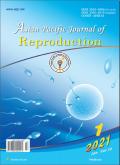以大车前草为基础的饮食调节阿特拉津诱导的大鼠睾丸毒性
IF 0.6
Q4 REPRODUCTIVE BIOLOGY
引用次数: 0
摘要
目的:评价车前草为基础的饮食对阿特拉津暴露大鼠睾丸毒性的调节作用。方法:在基础饲粮的基础上,以不同比例的车前草果肉粉代替玉米淀粉,分别配制50%、25%和12.5%车前草基础饲粮。在阿特拉津治疗前后的21天内,Wistar大鼠被喂食以车前草为基础的饲料,其浓度在基础饲料的12.5%至50%之间,分为两阶段:预防和治疗阶段。治疗模型(n=35)分为7组,每组5只,包括对照组、阿特拉津组、阿特拉津恢复组、阿特拉津加车前草饲粮50%组、25%组、12.5%组和阿特拉津加槲皮素组。预防模型(n=30)设6组,每组5只,分为对照组、阿特拉津组、50%、25%、12.5%车前草饲粮加阿特拉津组和槲皮素加阿特拉津组。测定性腺激素(睾酮、黄体生成素和促卵泡激素)、精子参数(精子活力、活力、形态和浓度)和睾丸功能指标(蛋白质、胆固醇、糖原、酸性磷酸酶、碱性磷酸酶和乳酸脱氢酶)。结果:阿特拉津组大鼠睾丸性腺激素、精子特征和睾丸功能指标明显降低,组织结构变性。然而,以大车前草为基础的饮食在预防和治疗模型中均能恢复性激素浓度、精液参数和睾丸功能指数。结论:车前草饲粮可通过调节性激素、精子质量、睾丸功能指数和睾丸组织结构来预防阿特拉津所致大鼠睾丸毒性。本文章由计算机程序翻译,如有差异,请以英文原文为准。
Plantain-based diet modulates atrazine-induced testicular toxicities in rats
Objective: To assess the potential of plantain-based diet in modulating testicular toxicities in rats exposed to atrazine. Methods: The plantain-based diet at 50%, 25% and 12.5% were prepared from the basal diet by substituting the corn starch with plantain fruit pulp flour at different percentages. Wistar rats were fed plantain-based diet in varying concentrations ranging from 12.5% to 50% of the basal diet for 21 days before or after atrazine treatment in a two-phase experiment: preventive and therapeutic phases. The therapeutic model (n=35) had seven groups with 5 rats each, including the control, atrazine, atrazine recovery, atrazine plus plantain-based diet 50%, 25%, 12.5%, and atrazine plus quercetin groups. The preventive model (n=30) had six groups of 5 rats, consisting of the control, atrazine, 50%, 25%, 12.5% plantain-based diet plus atrazine, and quercetin plus atrazine groups. Gonadal hormones (testosterone, luteinizing hormone and follicle-stimulating hormone), sperm parameters (sperm motility, viability, morphology and concentration), and testicular function indices (protein, cholesterol, glycogen, acid phosphatase, alkaline phosphatase and lactate dehydrogenase) were measured. Results: The gonadal hormones, sperm characteristics, and testicular function indices of the rat testis decreased significantly in the atrazine group alongside degeneration of the histoarchitecture. However, plantain-based diet restored the gonadal hormone concentrations, semen parameters, and testicular function indices in both the preventive and therapeutic models. Conclusions: Treatment with plantain-based diet protects against rat testicular toxicity caused by atrazine via the modulation of gonadal hormones, sperm quality, testicular function index as well as histoarchitecture of rat testes.
求助全文
通过发布文献求助,成功后即可免费获取论文全文。
去求助
来源期刊

Asian Pacific Journal of Reproduction
Veterinary-Veterinary (all)
CiteScore
1.70
自引率
0.00%
发文量
588
审稿时长
9 weeks
期刊介绍:
The journal will cover technical and clinical studies related to health, ethical and social issues in field of Gynecology and Obstetrics. Articles with clinical interest and implications will be given preference.
 求助内容:
求助内容: 应助结果提醒方式:
应助结果提醒方式:


